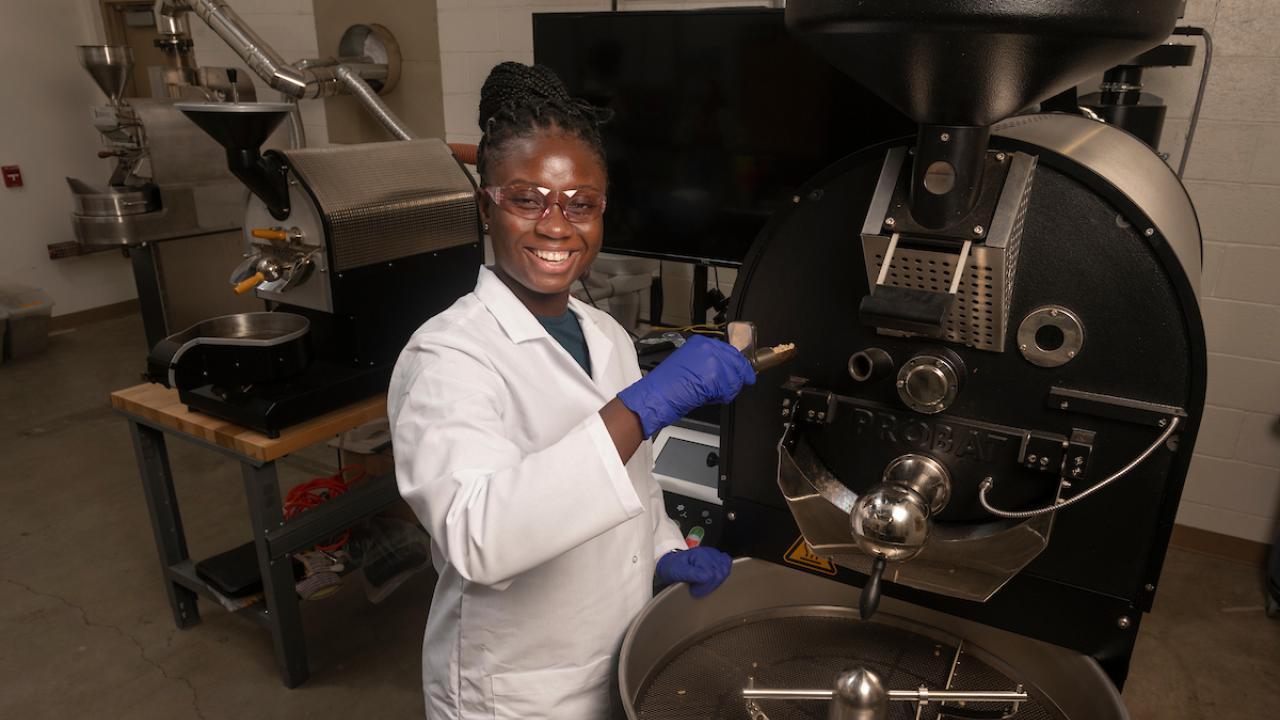
An Engineer's Guide to Coffee from Bean to Brew
Biological Systems Ph.D. student Laudia Anokye-Bempah dives into coffee science
For many of us, our coffee rituals are easy — push a button, pour water over fresh grounds, go to a coffee shop — but research at the Coffee Center in the UC Davis College of Engineering proves that the art and science of coffee is anything but simple. Through research conducted at the center, students like Laudia Anokye-Bempah, who investigates the kinetics of coffee roasting as part of her Ph.D. in biological systems engineering, are discovering how each step of the coffee process — from farm all the way to cup — affects the flavor of this beverage that many people consume every day.
For instance, geography has a major impact on the way coffee tastes, Anokye-Bempah explains, which is why coffee importers and roasters pay close attention to a coffee's country of origin and specific region.
"If you planted the same coffee variety in three different countries, be it Colombia, Brazil or Indonesia, the coffee would taste totally different at each location," she said. "This is due to several factors like the country's climate and altitudes."
The harvesting and processing techniques also significantly influence the final coffee product. During the harvest, coffee can be strip-picked from a tree all at once, leading to a mixture of beans at different ripeness levels, or selectively handpicked to choose only the ripe beans, which ensures a higher level of quality and consistency in the resulting coffee. Meanwhile, the pulped natural processing method results in coffees with enhanced sweetness and body, while the washed processing method produces cleaner and more consistent coffee.


Most people, however, don't have in-depth knowledge about their coffee's background before buying it to brew. Instead, they pick their coffee based on the roast level: light, medium or dark. Anokye-Bempah explains that the roast levels are good indicators of the coffee's acidity and overall flavor profile.
"During roasting, coffee beans absorb heat and lose moisture in the form of water vapor. As the roasting temperature rises, the increased vapor pressure within the beans causes them to expand and eventually 'crack,' creating audible cracking or popping sounds, commonly referred to as the first crack," she said. "My research shows that coffee is most acidic during the first crack, which is when you get light roasts. By the second crack — characterized by another series of popping sounds during roasting — the coffee's acidity decreases. Thus, light-roasted coffees have high acidity and fruity floral flavors, while dark roasts, which are typically roasted to second crack, have low acidity and darker flavors. Medium roasts have a medium acidity and body, and a rounded flavor profile."
As the first multidisciplinary center focused solely on coffee science and education at a university, the Coffee Center is expanding its research abilities with a new facility opening this spring.
By the time the coffee gets to your grinder or brewing mechanism, it has already gone through a long and winding flavor journey. But then there's the brewing of the coffee, and experiments at the Coffee Center have found that every step of any brewing process is also going have an effect.
When using an immersion brewing method like the French press, for example, the ground coffee remains in full contact with the brewing water throughout the extraction process, which typically results in a stronger coffee. In contrast, percolation or drip brewing methods involve the water passing through the coffee bed, limiting the continuous contact between coffee and water and producing a cleaner, milder brew.
The grind size of your beans also significantly impacts the extraction rate: Finer coffee grounds have a larger surface area, resulting in a higher extraction rate, which translates to stronger coffee, while coarser grounds yield a lower extraction rate, resulting in a diluted, sour cup with reduced sweetness and complexity.
"The acidity and pH of your water affect the chemistry, the size of the holes in your filters will affect the extraction rates, and we've even found that some paper filters and brewers transfer taste into your coffee," she added.
Basically, every aspect of the coffee-making process can hugely impact the final cup. So, the Coffee Center continues to investigate, providing quality research so everyday coffee drinkers can make the most-educated, or at least most-caffeinated, decisions.
"Coffee making is complicated. Many people have no idea that so much goes into making a cup of coffee," said Anokye-Bempah. "And that is why the science is important."
